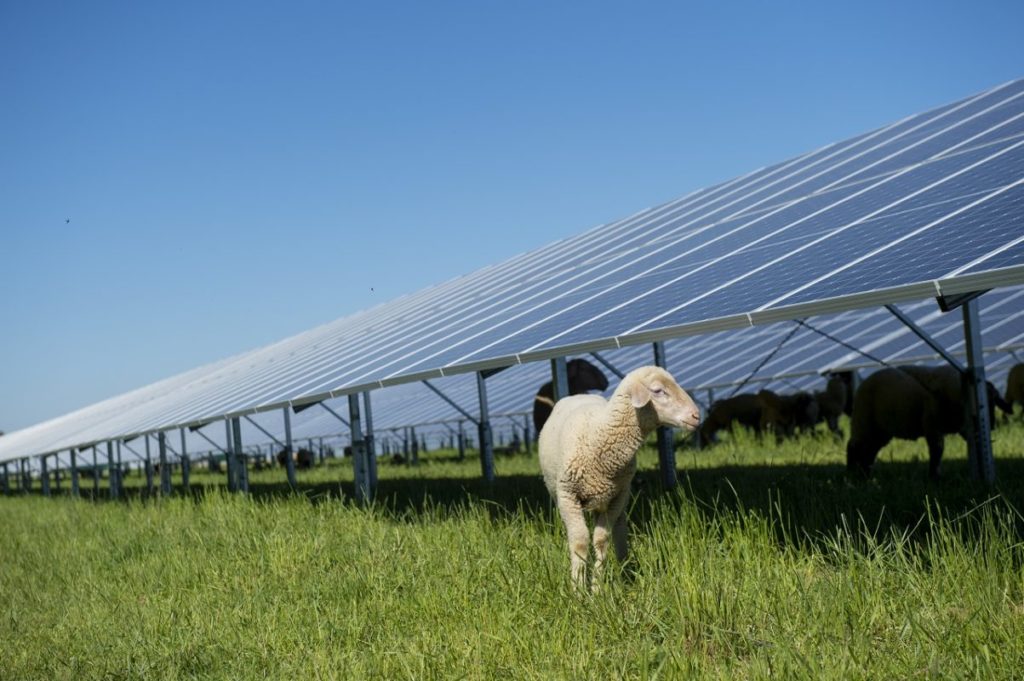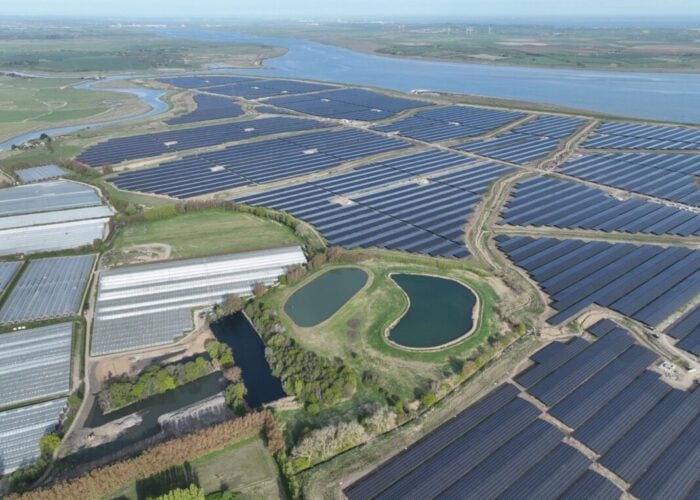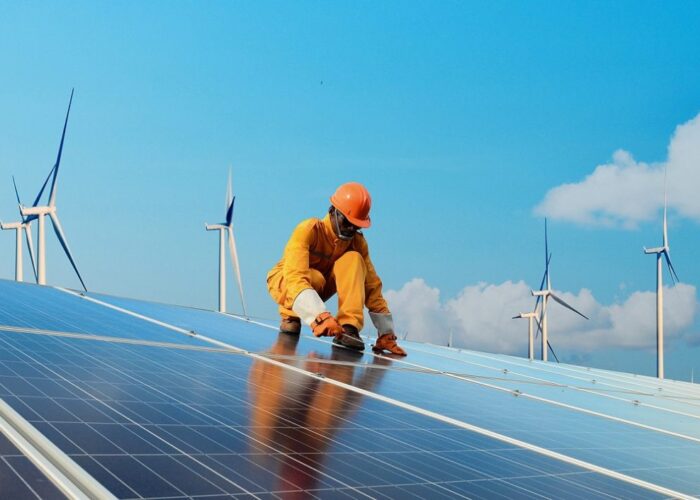
Last year, ex-UK Prime Minister Liz Truss labelled solar projects “paraphernalia”, while her successor, Rishi Sunak, promised to not let the country “lose swathes of our best farmland to solar farms”. Molly Lempriere investigates how much land the UK needs for utility-scale PV plants as it transitions to net zero, and whether the sector’s growth poses any threat to food security.
The impact of solar on land use hit headlines in the UK last year. Amid the cost of living crisis, the rising prices of food and energy have drawn particular focus, with some politicians and pressure groups suggesting that the two are at odds with each other.
Unlock unlimited access for 12 whole months of distinctive global analysis
Photovoltaics International is now included.
- Regular insight and analysis of the industry’s biggest developments
- In-depth interviews with the industry’s leading figures
- Unlimited digital access to the PV Tech Power journal catalogue
- Unlimited digital access to the Photovoltaics International journal catalogue
- Access to more than 1,000 technical papers
- Discounts on Solar Media’s portfolio of events, in-person and virtual
In September, food price inflation hit 14.6%, according to the Office for National Statistics, the 14th consecutive month of growth. At the same time, power prices have hit record highs due to the gas crisis, which is expected to continue for at least two years and possibly out to 2030.
With households up and down the UK facing these considerable pressures, some politicians began attacking solar farms, arguing that their development was ultimately a risk to food security.
The solar sector hit back, highlighting the minimal land use – currently all the solar in the UK would only cover half of the Isle of Wight – and the additional benefits to the agricultural sector of adopting the technology.
But with both food and energy security set to remain key priorities, how do you balance solar and land use?
Political uncertainty and ‘paraphernalia’
On 7 July, then-Prime Minister Boris Johnson announced he was resigning, triggering a Conservative leadership contest that saw Liz Truss and Rishi Sunak becoming the key candidates battling it out for the top job.
Throughout the husting process, solar became a key topic for both candidates, with Truss stating at an event on 1 August: “Our fields should be full of our fantastic produce … it shouldn’t be full of solar panels.”
At the same event, Sunak argued that under his leadership Westminster would understand the needs of rural communities, “making sure our fields are used for food production and not solar panels”.
Such comments, which looked to position solar and agriculture in opposition to each other, continued throughout their campaigns. Speaking in Darlington, Truss notoriously dubbed solar “paraphernalia”.
“I’m somebody who wants to see farmers producing food, not filling in forms, not doing red tape, not filling fields with paraphernalia like solar farms. What we want is crops, and we want livestock,” she said, continuing to highlight that both food and energy security are key issues currently due to the war in Ukraine.
Meanwhile Sunak looked to set out his “pro-farmer” stance in an op-ed in newspaper The Telegraph. “We must also protect our best agricultural land,” he wrote. “On my watch, we will not lose swathes of our best farmland to solar farms. Instead, we should be making sure that solar panels are installed on commercial buildings, on sheds and on properties.”
The comments caused significant concern in the UK solar sector, which has been growing at pace thanks to the low cost of the technology and the need to transition to low-carbon energy sources to tackle the climate crisis.
“The language used so far over the course of the Conservative leadership race regarding solar and land use is deeply concerning, and the REA urges the candidates to recognise that solar farms do not encroach on agricultural land,” said Mark Sommerfeld, head of power and flexibility at the Association for Renewable Energy and Clean Technology (REA), in August. “The solar industry aims to work in conjunction with, not against, agricultural use of land, commonly by either building on marginal land or ensuring multi-land use applications. In doing so, it provides additional revenue to farmers – supplementing, not stopping, more traditional livestock and arable farming activities.”
While the comments were undoubtedly concerning, the response in support of solar was strong and from a broad group of people and organisations, highlighting the minority appeal of such an attack.
“Some of Truss and Sunak’s comments were clearly designed to attract some die-hard NIMBY votes from the very narrow electorate that selects the leader of their party, notwithstanding the fact that 73% of Conservative Party members actually support solar farms,” wrote Chris Hewett, CEO of trade association Solar Energy UK, in a blog for PV Tech Power’s sister publication Solar Power Portal at the time.
“But what is interesting in the last month has been the breadth of criticism that their remarks have drawn from natural allies in right wing think tanks, media and the farming industry.”
How much land does solar actually use?
There is little evidence to suggest solar is at odds with agriculture in the UK. Currently, solar farms in the country have a combined capacity of around 14GW, according to research from Solar Media, of which 9.6GW is made up of ground-mounted installations.
Every megawatt of solar power requires about six acres of land, according to Solar Energy UK, meaning solar covers 230km2 in the UK. This is 0.1% of the land.
There is a total of 242,495km2 of land in the UK, according to Carbon Brief, 56% of which is agricultural land, with 70,000km2 used for pasture, and around 67,000km2 used for growing cereals and legumes.
Therefore it seems evident that the use of land for solar pales in comparison with agriculture, as it does for other land uses. For example, golf courses cover 1,256km2, while airports cover 493km2.
As the UK continues to transition to decarbonised sources of electricity, more utility-scale solar is being installed. However, even taking this into consideration, if every solar farm currently put forward was built it would still account for less than 0.4% of the UK’s agricultural land and 0.28% of the country’s entire land area, according to Solar Energy UK.
What type of land does solar use?
In the UK, the land is classified into grades from 1-5 as part of the Agricultural Land Classification (ACL) scheme, with a number of subsections within this. Grade 1 is considered excellent quality agricultural land, best for growing fruit and salad crops for example, whilst Grade 5 is very poor quality agricultural land, suitable mainly for just permanent pasture or rough grazing.
Solar farms are rarely built on land considered Best and Most Versatile (BMV) within the ALC, as there is a planning presumption against solar development. Instead the majority of solar farms are developed on land that is designated as 3B, therefore land which is only considered capable of supporting moderate yields of a narrow range of crops, principally cereals and grass.
However, there have recently been suggestions that these categories could change, with reports that former environmental secretary Ranil Jayawardena was looking to redefine land categories to make the development of ground-mount assets harder in October 2022. This would include extending the land considered BMV to include 3B, effectively banning solar from around 41% of land in England, or about 58% of agricultural land.
At the time, Solar Energy UK’s Hewett said the solar sector was “alarmed” by the attempts to put major planning rules in the way of the cheap, homegrown energy source.
“Solar power is the answer to so many needs and policy demands: it will cut energy bills, deliver energy security, boost growth and help rural economies. Ranil Jayawardena’s opposition to solar farms must surely make him part of the ‘anti-growth coalition’,” he added.
Recent changes in political leadership over saw Jayawardena step down from his role as Secretary of State for Environment, Food and Rural Affairs on 25 October, to be replaced by Thérèse Coffey.
But despite the hopes of the solar sector, the plans to redesignate BMV reportedly remain. Responding to a question within the House of Commons on 17 November, Coffey said: “It is really important that we make the best use of our land, to have the food security that was referred to earlier.”
“It is also important, when considering land use, that we think about the best place to put renewable energy. By and large, I think most people in this country would agree: let us have good agricultural land for farming, and let us use our brownfield sites for other energy projects too.”
Such a change is of significant concern for the UK solar sector, in particular in the middle of an energy crisis driven by high gas prices. In the Contracts for Difference (CfD) auction last year, solar cleared at a strike price of £45.99/ MWh (US$55.15/ MWh), making it one of the cheapest sources of power in the country.
Additionally, solar projects had the shortest development time of any of the technologies by far, making it one of the fastest routes to reduce the country’s dependence on gas.
What do farmers think?
Whilst it seems clear that there is a level of opposition from notable politicians, what do those who actually work with the land in question believe?
Currently, 22% of farmers in England have solar on their land, with 32% of farms having an installation in 2021. The partnership between solar and agriculture is well established, therefore, with around 70% of solar being owned or hosted on agricultural land.
Speaking at the UK Solar Summit in September 2022, Jonathan Scurlock, chief adviser for renewable energy and climate change at the National Farmers Union (NFU), highlighted that when it is done well, the land take for solar is “very modest” in comparison to other renewables.
By comparison, whilst solar covers around 19,000 hectares currently, 107,300 hectares of land was used in 2021 to grow crops for bioethanol. Scurlock therefore highlighted that the continued development of solar was “not going to bring the nation to its knees”.
Instead, he suggested that if farmers could get a solar installer onto their site in the next nine months, “Do it!” as the economics of an installation are extremely good. In particular given the volatility in the power market, solar installations can help provide long-term security for farmers, as they can for other commercial developers.
Government figures show that farming and other businesses paid 98% more for gas in the second quarter of 2022 than in the same period the previous year, and 45% more for electricity.
If the 78% of farmers without solar were to adopt it, over the next two years their energy savings and the potential revenue they could generate from the installation could be up to £1 billion. This would almost balance out the increase in fertiliser costs, which are estimated to be £1.1 billion over the next two years.
“Farmers are being hit by a double whammy of rising energy costs due to the surge in the gas price, and record prices for synthetic fertilisers which are made using gas. On top of that many are losing income as crops fail due to extreme weather driven by climate change. Some are choosing to leave the industry altogether as a result,” said Matt Williams, climate and land programme lead at think tank the Energy and Climate Intelligence Unit.
“MPs campaigning against solar farms might want to check that they are really reflecting the views of their constituents and not alienating them.”
Solar leases can offer farmers between £600 to £1,000 an acre, depending on the site, according to the NFU, meaning farmers can expect to make around four times as much from solar than from crops such as wheat and barley, and with a lot more security.
Additionally, well-designed solar farms can boost biodiversity, helping to support thriving wildlife habitats. Research from Solar Energy UK in May showed that solar farms can actually help reverse Britain’s declining wildlife through animal habitat enhancements, providing previously arable land with a break from intensive cultivation and ultimately boosting biodiversity, soil health and regeneration.
This built on research from Lancaster University released at the end of 2021 that found changes to how solar PV land in the UK is managed could see sites support four times as many bumble bees.
As such, it is probably unsurprising that many farmers are viewing solar as a way to diversify their revenue streams by providing guaranteed income over a period of time, in a way that can also boost the production of their land in the long run and tackle climate change – which is by far the biggest threat to land use, as changes to the weather in the UK could see BMV land reduce from 38.1% down to 11.4%, according to agricultural and environmental consultancy ADAS.
What could solar land use look like in the future?
The need for more solar and other renewables to decarbonise the energy sector in the UK, providing more security and resilience, is clear. As is the limited impact of land use that solar poses, helping instead to offer alternative revenue streams to farmers facing increasingly challenging market conditions, and helping to mitigate climate change, which poses a far greater risk to the industry.
But solar developers must still tread carefully, ensuring they are working together with communities and farmers to protect the countryside.
One particular area of consideration must be Nationally Significant Infrastructure Projects (NSIPs). These are projects over 50MW of capacity in England, which cannot be granted planning consent from local authorities but must instead submit an application for a Development Consent Order to the Planning Inspectorate.
At the time of writing, there are 12 of these projects submitted to the Planning Inspectorate, but only one that has been granted approval so far, the 350MW Cleve Hill Solar Farm, which was acquired by Quinbrook and renamed Project Fortress in September 2021.
Because of the sheer scale of these projects, they have attracted more local opposition than conventional solar farms. This was a concern highlighted by Scurlock, who said NSIPs pose a “reputational risk” when speaking at the UK Solar Summit.
Cleve Hill will be the sector’s first real look at what a solar farm of this scale will look like in the UK, and key lessons must be learnt from it, ensuring those that come after it are developed truly in partnership with the local communities.
Collaboration with the custodians of the countryside
Despite comments earlier in 2022, it seems clear that far from being in opposition for food security, solar can be a boon to the agricultural sector. The technology offers a level of revenue security, often utilising land that has minimal value in terms of crop production due to the ACL, as well as helping to tackle the long-term threat of climate change.
But there is an onus on the sector to continue to push for best practices in all its developments, ensuring there are biodiversity improvements and collaboration with the local community as well as farmers, in particular as the scale of sites in the UK continues to grow.







